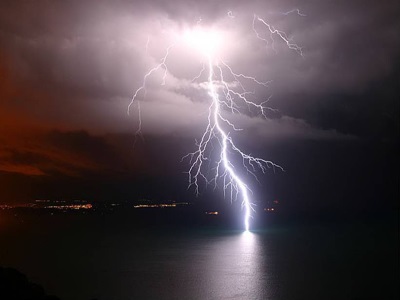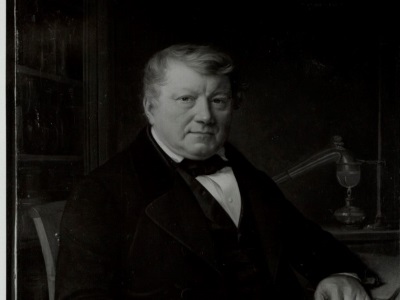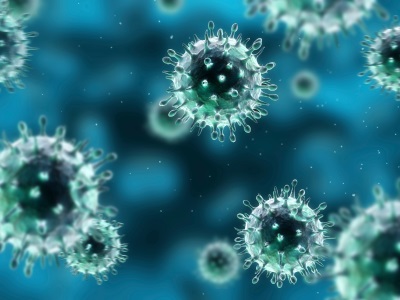
Ozone
Ozone is a natural gas composed of 3 oxygen atoms (O₃). Discovered in 1840 by the German chemist Christian Friedrich Schoenbein, ozone is naturally present in the atmosphere, where it is formed by the interaction of oxygen with UV rays in the upper part of the stratosphere. At lower altitudes it is formed by the interaction of atmospheric oxygen with the high-potential electric discharges of lightning.
At room temperature ozone is a colourless, heavier-than-air gas and has a characteristic odour. It is a highly unstable gas that tends to decompose into oxygen within a few minutes of formation. For this reason, ozone cannot be stored and must be produced for immediate use.
Due to its chemical composition, ozone is a very powerful oxidising and sanitising agent which reacts aggressively to viruses, bacteria, protozoa, germs, microbes, fungi, yeasts, spores, moulds, parasites, pollens, mites, etc. contained in the air, water and daily-use items, destroying the macromolecular components that are the basis of living cells and eliminating them by up to 99% or rendering them harmless through inactivation.
These organic microorganisms are also responsible for the unpleasant odours present in the air and in fabrics, which means ozone also is also a highly effective deodoriser.
These qualities make ozone ideal for combating allergies, asthma, respiratory difficulties, viral and bacterial infections, skin disorders, insects and harmful microorganisms, as well as an alternative to artificial preservatives for food treatment.
Its effectiveness and complete eco-compatibility (ozone naturally transforms into oxygen after a few minutes) make it the best and safest natural tool for sanitising, disinfecting and deodorising.
In Italy, the use of ozone for air and water treatment was recognised by the Ministry of Health with prot. no. 24482 of 31 July 1996 as a “natural method for the sterilisation of environments contaminated by bacteria, viruses, spores, moulds and mites”. The National Committee for Food Safety of the Ministry of Health, in a note dated 27 October 2010, recognised ozone as a “disinfectant and purging agent in the treatment of air and water”. In the United States of America, the FDA (Food and Drug Administration), by order of 26 June 2001, accepted the use of ozone as an “antimicrobial agent in the gas phase or in aqueous solution in production processes”. The use of ozone is permitted as a secondary food additive that is safe for human health.
The tables below illustrate the exposure times and ozone concentrations necessary for the destruction/inactivation of viruses, bacteria, fungi, spores, yeasts and protozoa and a selected scientific bibliography:
|
INACTIVATION OF VIRUSES AND BACTERIA WITH OZONE |
|||||||||
|
Body |
% of reduction | Time (min.) | Concentration (mg/l) | pH | Temp. (°C) |
Means of transport |
Type of reaction |
Comments | References |
| Escherichia Coli | 99,99 | 1,67 | 0,23 – 0,26 | 7 | 24 | Ozone demand free water | Completely mixed conti- nuous flow-through | Farooq and Akhlaque (1983) | |
| Legionella Pneumophila E221ADP |
99,997 |
20 |
0,32 |
7 |
24 |
Sterile distilled water | Batch | Edelstein et al. (1982) | |
| Legionella Pneumophila E102A3EP | 99,999 | 20 | 0,32 | 7 | 24 | Sterile distilled water | Batch | Edelstein et al. (1982) | |
| Mycobacte- rium Fortuitum |
90 |
1,67 |
0,23 – 0,26 |
7 |
24 |
Ozone demand free water | Completely mixed continuous flow-through | Farooq and Akhlaque (1983) | |
| Salmonella Typhimurium | 99,995 | 1,87 | 0,23 – 0,26 | 7 | 24 | Ozone demand free water | Completely mixed continuous flow-through | Farooq and Akhlaque (1983) | |
| Escherichia Coli | 99,9 | 19 | Init. 2,2
Res. 0,08 |
7,5 | 18 | Raw wastewater | Continuous flow-through | TSS 85 mg/l
COD 100 mg/l |
Joret et al. (1982) |
| Fecal Streptococcus | 99,6 | 19 | Init. 2,2
Res. 0,08 |
7,5 | 16 | Raw wastewater | Continuous flow-through | TSS 85 mg/l
COD 100 mg/l |
Joret et al. (1982) |
| Escherichia Coli | 99,998 | 0,16 | 0,51 | 7 | 20 | Water | Continuous flow-through | Boyce et al. (1981) | |
| Escherichia Coli | 99 | 0,33 | 0,085 | 7,2 | 1 | Water | Batch | Katzenelson et al. (1974) | |
| Poliovirus type 1 (Mahoney) | 99,7 | 1,67 | 0,23 – 0,26 | 7 | 24 | Ozone demand free water | Completely mixed continuous flow-through | Farooq and Akhlaque (1983) | |
| Poliovirus type 1 (Mahoney) | 90 | 0,75 | 0,32 | 4,3 | N.R. | Water | Completely mixed continuous flow-through | Roy et al. | |
| Coxackie- Virus B5 | 99,99 | 2,6 | 0,4 | 7,2 | 20 | Activated sludge reactor effluent | Batch | TSS 12,5 mg/l
NH3 1,55 mg/l BOD3 10,6 mg/l COD 37,2 mg/l |
Harakeh and Butle (1985) |
| Poliovirus Type 1 | 99 | 20 | 0,2 | 7,2 | 20 | Activated sludge reactor effluent | Batch | TSS 12,5 mg/l
NH3 1,55 mg/l BOD3 10,6 mg/l COD 37,2 mg/l |
Harakeh and Butle (1985) |
| Poliovirus Type 1 | 99 | 0,25 | 0,5 | 7 | 24 | N.R. | N.R. | Drinking Water and Health (1980) | |
| Enterie Virus | >98 | 19 | Init.4,10 Res.0,08 | 7,8 | 18 | Raw wastewater | Continuous flow-through | TSS 103 mg/l COD 231 mg/l TSS 12,5 mg/l | Joret et al.(1982) |
| Echo Virus Type 1 | 99 | 10 | 0,26 | 7,2 | 20 | Activated sludge effluent | Batch | NH3 1,55 mg/l BOD3 10,6 mg/l COD 37,2 mg/l TSS 12,5 mg/l | Harakeh and Butle (1985) |
| Bacteriophage f2 | 80 | 10 | 0,1 | 7,2 | 20 | Activated sludge effluent | Batch | NH3 1,55 mg/l BOD3 10,6 mg/l COD 37,2 mg/l TSS 12,5 mg/l | Harakeh and Butle (1985) |
| Human Rotavirus | 80 | 10 | 0,31 | 7,2 | 20 | Activated sludge effluent | Batch | NH3 1,55 mg/l BOD3 10,6 mg/l COD 37,2 mg/l | Harakeh and Butle (1985) |
| Poliovirus Type 1 Sabin | >97 | 0,16 | 0,21 | 7 | 20 | Water | Continuous flow-through | 5TU.bentonit | Boyce et al. |
| Coxackie A9 | >96 | 0,16 | 0,035 | 7 | 20 | Water | Continuous flow-through | 5TU.bentonit | Boyce et al. |
| Bacteriophage f2 | > 99,995 | 0,1 | 0,41 | 7 | 20 | Water | Continuous flow-through | 5TU.bentonit | Boyce et al. |
| INATTIVAZIONE DI FUNGHI SPORE E FERMENTI | ||||||||
| Organismo | % di riduzione | Tempo (min.) | Concentrazione (mg/l) | pH | Temp. (°C) | Mezzo di trasporto | Tipo di reazione | Referenze |
| Candida Parapsilosis | 99,6 | 1,67 | 0,23 – 0,26 | 7 | 24 | Ozone demand free water | Completely mixed continuous flow-through | Farooq and Akhlaque (1983) |
| Candida tropicalis | 99 | 0,3 | 0,02 | 7,2 | 20 | Ozone demand free water | Completely mixed continuous flow-through | Kawamura et al. (1986) |
| Pencilium Roqueforti | 99,06 | 0,45 | ||||||
| Pencilium Expansum | 99,06 | 0,36 | ||||||
| Pencilium Digitarum | 99,06 | 2,26 | ||||||
| Aspergillus Glaucus | 99,06 | 2,26 | ||||||
| Aspergillus Flavus | 99,06 | 2,45 | ||||||
| Aspergillo Niger | 99,06 | 9,1 | ||||||
| Rhizopus Nigricans | 99,06 | 6,06 | ||||||
| Mucor Racemosus (A) | 99,06 | 0,58 | ||||||
| Mucor Racemosus (B) | 99,06 | 0,58 | ||||||
| Oospora Lactis | 99,06 | 0,18 | ||||||
| Saccharomyces | 99,06 | 0,22 | ||||||
| Saccharomyces Spores | 99,06 | 0,29 | ||||||
| Saccharomyces Cerevisiae | 99,06 | 0,22 | ||||||
| INATTIVAZIONE DI PROTOZOI CON OZONO | ||||||||
| Organismo | % di riduzione | Tempo (min.) | Concentrazione (mg/l) | pH | Temp. (°C) | Mezzo di trasporto | Tipo di reazione | Ct (mg/min) L |
| 99 | 7,8 | 0,55 | 7 | 6 | Water | Batch | 4,23 | |
| Naeglaria gruberi | 99 | 2,1 | 2 | 7 | 5 | Water | Batch | 4,23 |
| 99 | 4,3 | 0,3 | 7 | 25 | Water | Batch | 1,29 | |
| 99 | 1,1 | 1,2 | 7 | 25 | Water | Batch | 1,29 | |
| 99 | 12,9 | 0,13 | 7 | 5 | Water | Batch | 1,94 | |
| Glardia muria | 99 | 2,8 | 0,7 | 7 | 5 | Water | Batch | 1,94 |
| 99 | 9 | 0,03 | 7 | 25 | Water | Batch | 0,27 | |
| 99 | 1,8 | 0,15 | 7 | 25 | Water | Batch | 0,27 | |
| 99 | 5,3 | 0,1 | 7 | 5 | Water | Batch | 0,53 | |
| Glardia lamblia | 99 | 1,1 | 0,5 | 7 | 5 | Water | Batch | 0,53 |
| 99 | 5,5 | 0,03 | 7 | 25 | Water | Batch | 0,17 | |
| 99 | 1,2 | 0,15 | 7 | 25 | Water | Batch | 0,17 | |
Breve bibliografia:
- The Application of Ozone Technology for Public Health and Industry, M. Franken
- Use of Ozone to Reduce Bacteria and Moulds in the Air and on Surfaces, K. Klanova,A. Lajc˘ikova
- Microbiological Aspects of Ozone Applications in Food: A Review, M.A. Khadre, A.E. Yousef , J.G. Kim
- Ozone Decontamination of Bioclean Rooms, T. Masaoka, Y. Kubota et. al.
- Bactericidal Effect of High Airborne Concentration on Escherichia coli and Staphylococcus aureus, Kowalsky et al.
- Characteristics of the Bactericidal Effect of Ozone Gas on Pathogenic Bacteria in Hospitals, F. Sakae et al.
- Demonstration of a Hermetic Airborne Ozone Disinfection System: Studies on E. coli, W.J. Kowalsky et. al
- Ozone Disinfection of SARS-Contaminated Areas, Kenneth K. K. Lam 9




